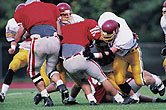
WEDNESDAY, May 16 (HealthDay News) — Using tests of mental function and special helmets to measure impact from hits to the head, a new study found that some college athletes in contact sports showed signs of temporary decline in learning ability following repetitive head injuries.
Followed over a single season, 24 percent of football and hockey players performed poorly on a postseason test of new learning compared to 4 percent of athletes in non-contact sports, such as track, crew and cross-country skiing.
However, cumulative effects from years of playing hockey or football were not seen in these athletes from three NCAA Division I schools, and most players showed no decline in learning capacity at the season’s end, the researchers said.
“Across the board, the contact athletes that were hitting their heads in their sports were not performing differently at the beginning of the season or significantly so at the end of the season, if you were just looking at the group averages,” said study author Dr. Thomas McAllister. “To a certain extent I think this is reassuring and good news.”
But “there may be a subgroup of athletes that for hitting their heads over and over again, it’s not a good thing,” said McAllister, a distinguished professor of psychiatry and neurology at Geisel School of Medicine at Dartmouth.
More research is needed to determine if this damage is short-term or long-lasting, the authors said.
The study, published in the May 16 online edition of Neurology, looked at 214 varsity football and hockey players enrolled at Brown University, Dartmouth College and Virginia Tech between 2007 and 2010. They were compared with 45 non-contact sport athletes.
Most of the athletes were male. None had a history of concussion, and this study did not focus on concussion.
For the study, the contact-sport players wore special helmets fitted with devices that counted head impacts above a certain force and recorded different types of acceleration, such as “rotational acceleration — around the center of gravity of the head,” McAllister explained.
During a season, contact players sustained 469 hits to the head, on average.
To look at possible effects of all these hits on classroom performance, athletes took a computerized “ImPACT” test — widely used to screen for concussion — right before and after their season to look for declines in thinking and memory skills. Overall, no significant differences were seen between contact or non-contact players.
Also, “there was no evidence for a cumulative effect over the years,” McAllister said.
Digging deeper, the researchers gave a smaller group of athletes from just one school a more extensive battery of neuropsychological tests.
They found that in one test of verbal learning ability, “close to four times as many of the contact-sport athletes were doing [significantly] more poorly than one would have otherwise predicted,” McAllister said.
He said other research suggests that genetic differences might make some players more vulnerable to the effects of head injury than others.
Dr. Howard Derman, medical director of the Methodist Concussion Center in Houston, said that he would not conclude that most of the players had been unharmed. Because the study only tested athletes before and after the season, the findings “would give me a false sense of security,” he said.
Testing throughout the season would be more likely to pick up short-term changes in brain function, he said.
“What if they do a baseline test, then one at four weeks, one at eight weeks and one at 12?” Derman suggested. “So if we can say [at any point] there was a difference, that may imply that there may be something going on, and just at the end, it’s recovered. But that doesn’t mean there hasn’t been microscopic damage to the brain during those periods.”
“The implication — that there’s no change with the ImPACT study, therefore there’s no change in the brain — is not a conclusion I would reach, unless there were no changes in the ImPACT test sequentially during that time,” he said.
Results from this research can’t be extrapolated to non-college athletes, the study noted. It was funded by the U.S. National Institutes of Health and the National Operating Committee on Standards for Athletic Equipment.
More information
Learn about severe brain damage at Boston University’s Center for the Study of Traumatic Encephalopathy.

